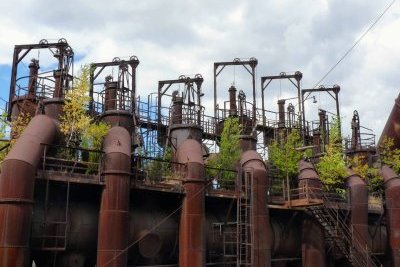
An “aside” to start with - Several reviewers describe Volklingen as a “Steel Mill”. That is it is NOT – so the “slot” is still there for some country to nominate one of those!! Volklingen is an integrated “Ironworks” and its output still has a lot of processing to go through before it can be called “steel” – let alone before that “steel” can be converted to something useful, by being rolled in a “mill”. An analogy would be to call a “flour mill” a “bakery”! From the viewing platform within the WHS one can see the nearby modern steelworks of “Saarstahl” which does indeed produce and roll “steel” – no longer from molten iron provided locally by Volklingen Ironworks but transported by rail from modern Blast Furnaces at Dillingen (c 20kms away) in huge “torpedo” ladles.
The star to me of the visit to Volklingen was undoubtedly the chance to view a Blast Furnace close up. Steps go all the way from the Charging Platform (where the raw materials were fed in) at 27m up, down to the Tapping Floor (where the “hot metal”, i.e molten iron, was “let out”). Indeed a viewing point is set even higher at 45m on top of the blast engines. The “Blast furnace” has been a crucial piece of technology in human development and this historic late 19th/early 20C example is well worth its place on the list. But the objective is much greater than this – rather to preserve the entire integrated plant with all its pre and associated processes, and there must be concerns about how all this is going to be achieved in the long run. “Buildings” are one thing but old industrial plant in the open air is another. Rust and residual toxicity from the processes and the construction materials will surely wreak their havoc. Whilst the areas through which tourists are allowed to walk (freely without guides in wonderful contrast to the “guided tours only” policy operated within plants at Zollverein!) are well maintained, other parts of the plant look distinctly “fragile”. The plant was closed in 1986 and its historic fabric shows that it will have been run for many decades before that on an “essential maintenance” basis only. There is an attempt to make a virtue out of some of the degradation via its presentation as a “Paradise Garden” where “nature” is returning (Zollverein has adopted a similar stance!) - but this can only be done in areas where gradual decomposition is acceptable. From the Charging Floor it could be seen that large areas of the adjacent structures were being taken over by trees which had seeded themselves high up on the structures (photo). Similarly many of the operator cabins are made at least partly of wood and these were visibly rotting. This 2006 article from ICOMOS describes the problem. I liked the comment about the need to “avoid a large-scale misinterpretation of the monument (e.g. as a kind of “disneyland”)”. Are you listening Zollverein??
The other parts of the site had their interests too. Again, unlike at Zollverein, the Coke Works is available to go round without a guide. I could have done without the “Ferrodrom” science centre and the “art works” but found these less intrusive than their equivalents at Zollverein. At least there isn’t a Ferris Wheel - yet?? The Compressor hall is also an “Event Centre” – but at least that is across the street and is having its own entrance built (Yet another German WHS which was covered in scaffolding which we saw during our tour!). The video presentation was superior to that at Zollverein too (with, I think, a cycle of 3 German shows to 1 French but no English) and at least had something to do with the WHS. Signage was also pretty good (again superior to that at Zollverein) in German, French and English – but usually written on clear plastic which was often rather difficult to read. Entrance is a steep 12 Euro – but all that maintenance will have to be paid for somehow I guess. An “average” visit would seem unlikely to last less than 2 hours – we spent just under 3. Parking is easy in a large (free) park across the road from the entrance
One little “historic” tit-bit which emerged during our visit - This area didn’t become a part of the FDR until 1957 – from 1945 it was in the nominally independent “Saar Protectorate” and was integrated economically with France. One of the (older!) security guards we conversed with (in French) said that his father had told him to learn French in case the area remained a part of France! How times change!!
More on
Comments
No comments yet.
